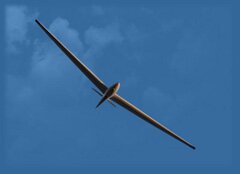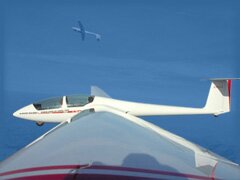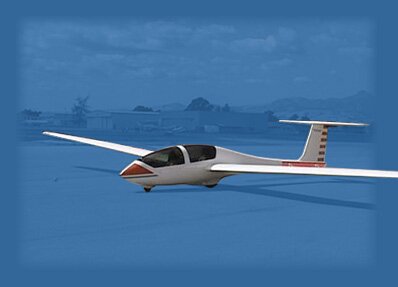|
||||

Lessons can be scheduled at your convenience. The closer together the lessons are, the easier it is to build on the knowledge gained from the previous lessons, and the faster you will learn. Most people try to fly at least once a week, and most prefer to take more than one flight during each lesson. The glider you will fly has dual controls, and your instructor will sit behind you with all the directional controls that you have and will show you the control motions or follow along with you as you are learning to glide the glider. You may begin your training at the age of 12, but must be at least 14 years or older to solo. Most instructors feel that 30 to 35 flights of pre-solo flight time are the minimum needed for most people with no previous flight experience. An experienced private power pilot can generally solo a glider in 10 flights. Learning to fly a glider safely is easy. The instructor can teach you the mechanics of flying the aircraft in just a few lessons. While learning to fly a glider safely around the airport is easy, learning to fly one skillfully is considerably more difficult. The sport requires alertness, self-control and self-discipline. It is important to maintain your respect for the sport regardless of your experience. Do not be led too quickly into thinking that you have learned all there is to know. Some pilots are content, at least for a while to soar around an airport. Others find exhilaration and satisfaction in cross-country flight and ultimately in competing with other pilots. Learning while flying is fun; a fine balance of determination, flexibility and much practice is necessary to gain the proficiency and skills you will need to get the most out of your glider and your rating. The more you learn, the more fun and personal satisfaction you will have. Whatever your goals may be, the 1-800-SKYRIDE Centers will help you achieve them, and send you on the path to enjoying the exciting world of soaring! How to earn Glider Private Pilot CertificateFAR61.109(f) For a glider category rating.
|
||||

Evergreen Soaring provides free training for members. Glider pilots are licensed by the FAA, just like powered aircraft pilots. You'll learn to control the glider safely and precisely, navigate, and develop a basic understanding of weather and other aviation topics. If you have no flying experience, you can solo after 25 or 30 instructional flights. If you are a power pilot, it may take between 10 and 15 flights. After another 20 to 30 flights, you'll be ready to take your first flight test. The total time from first flight to license depends on how frequently you fly. You must also pass written and oral exams. Evergreen Soaring offers free ground schools to prepare students for the written exam. The written exam may be taken any time within two years prior to the flight test. The oral exam is given on the morning of the flight test by an FAA designated pilot examiner. You must be a member before you can start training. But you can give it a try first. Students do not need any FAA paperwork to start training, but a valid FAA student license is required before going solo. This may be picked up any time prior to solo from the FAA, Flight Standards District Office, 1601 Lind Avenue S.W. Suite 260, Renton, WA 98055-4056 (), or from a designated examiner. There is a small fee if the student license is received from a designated examiner. No medical examination is required to get a student license, but the applicant will have to sign a written statement that he or she has no medical or physical condition that would impair his ability to fly. You must be 14 years old to get a student license, and 16 to get a full glider pilot's license. At the time the student solos, the instructor will endorse the student license for the type of glider. The student must have an endorsement for each type of glider he flies solo. In addition, the instructor must enter an endorsement in the student's logbook. The logbook endorsement is good for ninety days only and must be renewed in order for the student to retain solo privileges. |
||||

The student who already has a pilot license in other aircraft does not need any additional FAA paperwork to fly gliders solo. A logbook endorsement, however, is required to fly solo, and that endorsement must be renewed every ninety days. Note: As a pilot, you are responsible for being legal to fly. Here is a summary of some of the requirements for flying a glider. Click on the links to read the actual Federal Aviation Regulations for the details.
|
||||
|
 Your first step into the thrilling world of soaring is to take an introductory, or discovery, flight in a glider. That flight will initiate you into a world that you have previously only dreamed of discovering. It is so exciting, that you will want to explore it and become part of it. This desire, along with your commitment, will lead you on the path to becoming a part of the world of the glider pilots.
Your first step into the thrilling world of soaring is to take an introductory, or discovery, flight in a glider. That flight will initiate you into a world that you have previously only dreamed of discovering. It is so exciting, that you will want to explore it and become part of it. This desire, along with your commitment, will lead you on the path to becoming a part of the world of the glider pilots.

